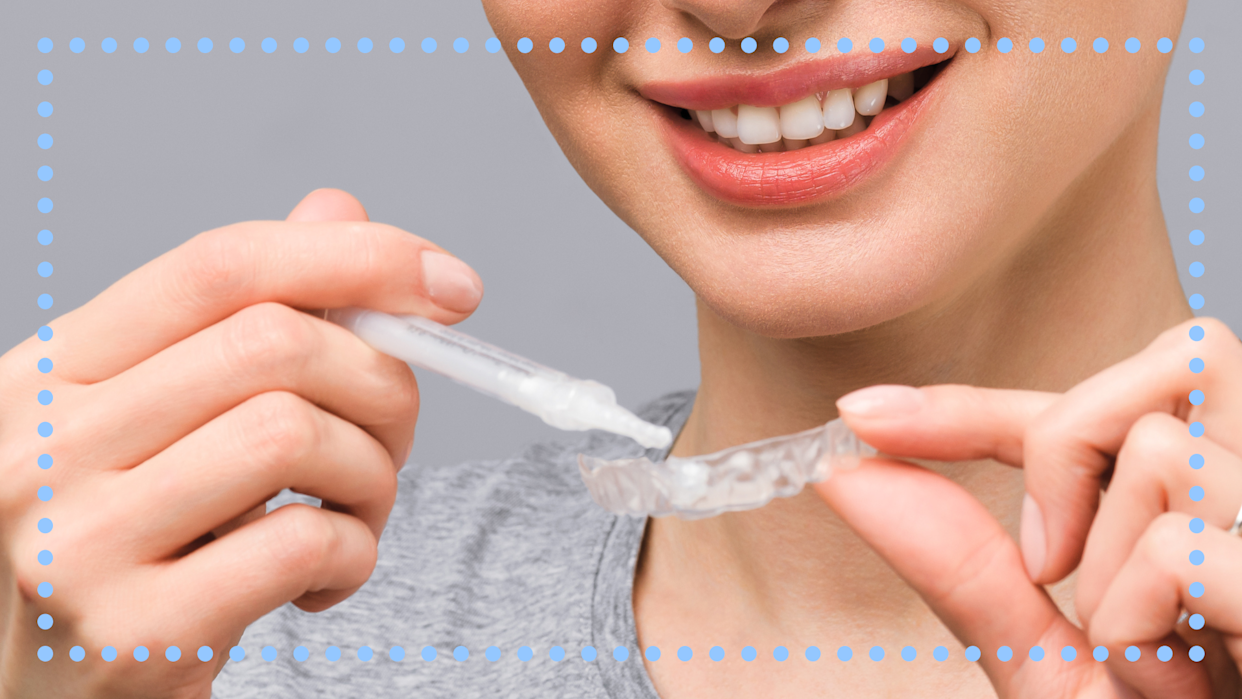Many desire a whiter, more dazzling smile, especially when daily habits like enjoying coffee or red wine leave their mark. The good news is that achieving a noticeably brighter smile no longer strictly requires a dental office visit.
Thanks to advancements in oral care products and reliable natural remedies, effective and dentist-approved at-home teeth whitening solutions are readily available. Whether you prefer the simplicity of over-the-counter strips or explore natural alternatives, a radiant smile is closer than you think, empowering you to boost your confidence from the comfort of your own home.
Understanding At-Home Teeth Whitening
Teeth whitening primarily involves using specific agents such as carbamide peroxide, hydrogen peroxide, or even common baking soda to lighten the natural shade of your tooth enamel.
While professional in-office treatments offer immediate, dramatic results for severe discoloration, at-home methods are remarkably effective for addressing everyday stains and achieving noticeable improvements. It’s crucial to understand that these solutions are designed to work on natural teeth and may not yield the same results on dental work like fillings or crowns.
Professional Guidance and Scientific Backing
To ensure the most practical and safe recommendations for at-home teeth whitening, extensive research was conducted. This involved consulting with a panel of five experienced dental professionals, including dentists and dental hygienists, who provided invaluable insights.
Their expert advice was further corroborated by a thorough review of scientific publications and journals, guaranteeing that the suggested methods are both efficient and grounded in reliable data. This comprehensive approach ensures you receive trustworthy guidance for your journey to a brighter smile.
Top At-Home Teeth Whitening Methods
A variety of options exist for safely brightening your smile from home, ranging from convenient over-the-counter products to accessible natural remedies.
Over-the-Counter Solutions: Strips and Trays
- Whitening Strips: These popular products consist of thin, adhesive strips coated with a whitening gel. Applied directly to the teeth, they are typically worn for 15 to 30 minutes daily. Most kits provide a 30-day supply, making them quite user-friendly. Dental hygienist Trudy Hogg notes that due to their lower gel concentration, strips generally cause minimal tooth sensitivity, though results may take a bit longer to become fully apparent. Dr. Nicole Mackie, DDS, highlights that certain brands, such as Crest 3D Whitestrips, hold the prestigious approval of the American Dental Association, affirming their safety and effectiveness for home use. However, Dr. Ricky Marshall, DMD, advises against using strips for deep, noticeable stains, permanent discoloration, or if you have existing cavities, fillings, or other dental work on the surfaces you wish to whiten.
- Whitening Trays with Gel: Also known as bleaching trays, these systems involve a flexible tray that molds to your teeth. Depending on the product, the trays might come pre-filled with a bleaching agent or require you to apply the gel yourself. Dr. Rhonda Kalasho, DDS, explains that these gels typically contain low concentrations of peroxide-based compounds, such as 15% hydrogen peroxide or 35% carbamide peroxide. Users generally wear these trays for 30 to 60 minutes per session to achieve desired results.
The Role of Whitening Toothpastes
While a 2018 study indicated that toothpastes containing chemical whitening agents are more effective than purely natural alternatives, they are generally not as potent as strips or trays for significant whitening. Their primary benefit lies in maintaining a brighter smile and preventing new stains. For enhanced effects, many dental professionals suggest supplementing regular brushing with a mix of baking soda and hydrogen peroxide, a more active approach to daily oral care.
Natural Whitening with Baking Soda
Baking soda stands out as a versatile natural option for stain removal. It can be mixed with water to form a paste or combined with hydrogen peroxide for an enhanced cleaning solution. Dr. Nicole Mackie, DDS, emphasizes that while baking soda shouldn’t replace your regular toothpaste, it can significantly upgrade your daily dental routine.
It actively helps to break down plaque, balance the mouth’s pH levels, and contributes to noticeable tooth whitening. Consistent use can effectively combat the bacterial buildup that leads to staining after meals.
Preventing Stains: Daily Habits for a Dazzling Smile
Beyond active whitening, preventing stains is key to maintaining a bright smile. Dr. Nicole Mackie, DDS, offers practical daily habits to minimize discoloration:
- Limit Stain-Causing Foods & Drinks: Reduce your intake of culprits like coffee, red wine, tomato sauce, and dark sodas.
- Use a Straw: When consuming heavily pigmented beverages, using a straw can help minimize contact with your teeth.
- Rinse After Eating/Drinking: Swishing water around your mouth immediately after consuming stain-causing items can help wash away pigments before they set.
- Eat “Scrubbing” Foods: Incorporate crunchy fruits and vegetables like apples, carrots, and celery into your diet, as they naturally help to clean tooth surfaces as you chew.
Potential Side Effects and Safety Precautions
While generally safe, at-home teeth whitening, like any DIY health treatment, requires careful application to avoid potential side effects. Dr. Shahrooz Yazdani, DDS, highlights that excessive or improper use can impact tooth enamel, the vital outer layer protecting your teeth from physical, thermal, and chemical damage.
Common side effects include temporary tooth sensitivity and gum irritation, often resulting from leaving whitening strips or gel trays on for too long. If sensitivity occurs, Dr. Ricky Marshall recommends using a toothpaste specifically designed for sensitive teeth, such as Sensodyne. Trudy Hogg, a dental hygienist, also warns of rare but possible allergic reactions (itching, swelling, discomfort), advising immediate discontinuation of the product and consultation with a dentist if experienced.
Methods to Approach with Caution (or Avoid)
Not all popular “whitening” methods are created equal, and some should be approached with extreme caution or avoided entirely. Activated charcoal, for instance, despite its popularity in some circles, lacks substantial scientific evidence to support its claims for teeth whitening.
A 2023 review suggested that activated charcoal is not only less effective than more established at-home options like baking soda but may also be more abrasive on tooth enamel, potentially causing harm rather than benefit. Additionally, as a general safety precaution, Trudy Hogg advises that individuals who are pregnant or nursing should avoid teeth whitening treatments altogether.
Choosing the Right Whitening Method for You
Selecting the best at-home teeth whitening method involves a personal assessment. Consider your level of tooth sensitivity, the type and severity of stains you have, and your personal preference for application (e.g., strips vs. trays).
While over-the-counter whitening strips are often the most widely recommended and conveniently available option, especially those approved by the American Dental Association, it’s always prudent to consult your dentist if you have significant concerns about your tooth discoloration, existing dental work, or any underlying oral health conditions before embarking on a new whitening routine.
Expert Insights: FAQs on Teeth Whitening
To address common inquiries, here are some frequently asked questions about teeth whitening, with expert perspectives:
What’s the safest method of teeth whitening? According to Trudy Hogg, the safest method is professional “chairside” or in-office whitening performed by a licensed dental professional. During these appointments, your tongue, cheeks, and gums are meticulously isolated and protected from the concentrated whitening gel, minimizing irritation.
What do dentists typically recommend to whiten teeth? Dentists frequently recommend professional in-office treatments for dramatic results. For at-home use, they often suggest ADA-approved teeth whitening strips or a diligent daily routine involving brushing with a mix of baking soda and hydrogen peroxide.
What is generally considered the best way to whiten your teeth at home? While various effective methods exist, whitening strips are widely regarded as one of the most convenient and effective at-home solutions, particularly those products that have received certification for safety and efficacy from professional dental organizations like the ADA.
Confidently Brighten Your Smile
Achieving a brighter, more confident smile is an attainable goal through safe and effective at-home teeth whitening practices. By understanding the various methods available, adhering to safety precautions, and incorporating daily stain-prevention habits, you can significantly enhance your smile without always needing a trip to the dentist.
Always remember to prioritize your oral health, and when in doubt, a quick consultation with your dental professional can provide tailored advice for your unique needs, helping you confidently showcase your dazzling pearly whites.








